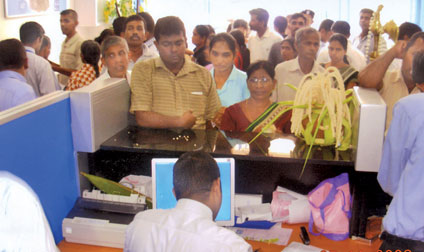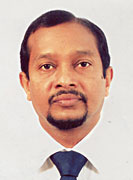Cooperative Year to be celebrated on grand scale
By L.S. Ananda WEDAARACHCHI
A number of programs will be implemented this year to mark the
'Cooperative Year 2012' declared by the United Nations, said
Cooperatives and Internal Trade Ministry Additional Secretary
(Cooperatives) A.P.G. Kithsiri.
The cooperative network has expanded during the past few years due to
the progressive policies of government, he said.
 |
|
Sanasa Bank branch in
the Eastern Province |
The Sunday Observer interviewed Cooperative and Internal Trade
Ministry Additional Secretary A.P.G. Kithsiri and Sanasa Development
Bank Chairperson Samadanie Kiriwandeniya.
Excerpts of the interview:
Q: The Cooperative Movement in Sri Lanka has grown during the
past few years even to compete with private sector supermarkets. How did
this change take place?
A: The Cooperative network has a strong marketing network with
over 6,000 marketing outlets.
The overdue loans and over drafts are a burden to the Cooperative
Societies when such liabilities were written-off on a directive by
President Mahinda Rajapaksa. Financial assistance to open Mini Coop
Cities were provided in 2008 marking a new era of the Cooperative
Movement.
Q: Could you explain the present strength of the Cooperative
Movement in Sri Lanka.
A: The Cooperative Movement is a multifaceted entity that has
diversified into agriculture, industry and finance. Cooperative is a
devolved subject now transferred to provincial Councils. Each PC has a
Cooperative Minister and a Cooperative Department. There are 13 apex
Cooperative Societies within the purview of the central government.
Sanasa Development Bank Chairperson Samadanie Kiriwandeniya
Q: The SANASA thrift and Credit Cooperative Society played an
important role to popularise the Cooperative concept in Sri Lanka. Your
Comments?
A: SANASA audited by the Cooperative Department has set up
8,400 village and urban based Cooperative Societies.
There are also 12 companies set up for construction,
infrastructure-development and finance.
The Sanasa Development Bank is one of such projects. It has over
4,200 shareholders in various parts of the Island.
The main feature of the Sanasa Development Bank is its down to earth
approach to various segments of society specially the rank and file
among whom self-employees, villagers, and workers. Sanasa has formulated
a micro credit scheme for those who do not have access to commercial
banks.
Q: The Northern and Eastern people who suffered from LTTE
terrorism for 30-years to return to normal life, it was Sanasa that came
forward to assist them, can you elaborate the Sanasa activities in the
North and the Eastern provinces.
A: The Sanasa Cooperative Thrift Societies had a strong base
in Eastern and Northern Provinces during 1970s until the rise of LTTE
terrorism.
 |
 |
| Samadanie
Kiriwandeniya |
A.P.G. Kithsiri |
We moved into the Eastern province immediately after the tsunami
disaster.The Sanasa Development Bank's approach was totally different
from the Commercial Banks. While the Commercial Banks were functional in
the Eastern Province, Sanasa ventured into rural areas. "Our approach
was simple. Now 16 Sanasa Bank branches operate in the Eastern Province.
The Sanasa Cooperative officers cater to the social and economic
needs of the villagers. Micro level loans have been given to them for
livelihood projects and house construction. The Kaluwanchikudi Sanasa
Bank branch where over 1,000 accounts were opened within a year bears
evidence to its popularity in the Eastern province.
Q: What progress has the Bank achieved in the Northern
Province?
A: Four Sanasa Bank branches were set up in Kilinochchi, Tale,
Jaffna and Vavuniya. Initially we felt that in the Northern province
specially the Kilinochchi people were backward in their approach to
banking due to terrorism. This situation has changed. The Bank's policy
is to assist the people to overcome the poverty.
The Sanasa Bank has invested five times more what it had collected
from the Northern and Eastern provinces. It is remarkable that the
people make the best use of the Micro level loans in the contest of
livelihood projects in agriculture and small-scale industries.
Q: You have already created a strong rural banking network.
What will be the next step of your blueprint?
A: During the past 15 years Sanasa Development Bank fullfilled
the financial needs of the rural community. Over 87 branches are in
operation in rural areas today.
Essentially the next priority will be the urban market where there
are constant money exchanges.
We will set up ATMs in main towns where there is a concentration of
government servants, businessmen private sector employees and
professionals. Non Resident Foreign Currency - (NRFC) - account scheme
will be launched this year for the benefit of Sri Lankan expatriates.
Co-banking activities will also be pursued to transform the Sanasa
Development Bank into a fully-fledged Commercial Bank.
|

